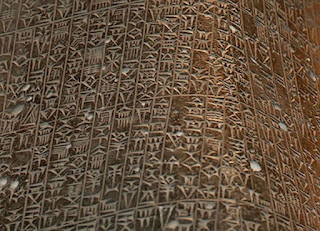c1795 BCE HAMMURABI (c1795-1750) the Great, is a Semitic Amorite king of Assyria who unites the individual city states of Mesopotamian under one code of Law. This Law is reminiscent of that of Moses because Hammurabi also received his Law from a god, the god being the sun god Shamash. The code is inscribed on a black basalt stele which is capped by a relief sculpture of the king receiving the inspiration for it from the flame-shouldered sun god. The event takes place on a mountain, (097)as it does in turn for the later Moses. Hammurabi is also written Hammurapi, which probably refers to the western Semitic healing god, Hammu. (231)
Hammurabi stele of Laws. Louvre
The laws of Hammurabi and the future Moses (1362 BCE) may have a common origin in those of the Sumerian King Lipit-Ishtar (1865 BCE) or the even to be descended from the early King Urukagnia of Lagash [c2340].
Hammurabi was the sixth of eleven kings in the Old Babylonian (Amorite) Dynasty. New data puts his reign from 1728 to 1686 and he enacted the law of the land in his second year. An Elamite raider, Shutruk-Nahhunte, carried off the stela to the old Elamite capital Susa, between 1207-1171 BCE. (192)
1765 In about 1765 BCE, the Semites will conquer Sumeria and establish the New Babylonian Empire, covering the whole of Mesopotamia and centred on the ancient city of Babylon sited on the River Euphrates (modern Iraq). (13)In the time of this ruler the supreme triad will be composed of the gods of Heaven, Earth and Water; Sin, Shamash and Ishtar. Sin the Moon, was regarded as the most powerful of the three. (15)
Symbols of Venus Moon & Sun
Star of Ishtar, Crescent of Sin, disk of Shamash
SIN was the original Moon-god of Mount Sinai, “Mountain of the Moon”. He was born of the Virgin Queen of Heaven, Nanna or Inanna and ruled the Land of Sinim (Isaiah 49:12) an older form of Zion. The Chaldean name for Sin was Kingu. As Sin, he was the god who received the Tablets of Law from the primal Mother Goddess of Creation, Tiamat. Sin will also be the god of Moses in the future; the Jehovah of the Hebrews was simply another transformation of the primitive lunar deity of Arabia. [13]
The dragon/serpent Tiamat
From around this time, military society starts to grow and women’s status gradually declines as a result. (9)
1738 This is the Greek Manentho’s date for the beginning of the New Kingdom of Egypt covering Dynasties XVII-XX.
c1700 BCE A section of the wandering Indo European tribes known as the Hittites settle in Anatolia (Turkey) and establish a capital at Hattusha. (76)
This is thought to be the estimated time of the creation of the Ecliptic Zodiac comprised
of stellar groupings.
Babylonian Stele depicting astronomical symbols c1120 BCE
[British Museum]




